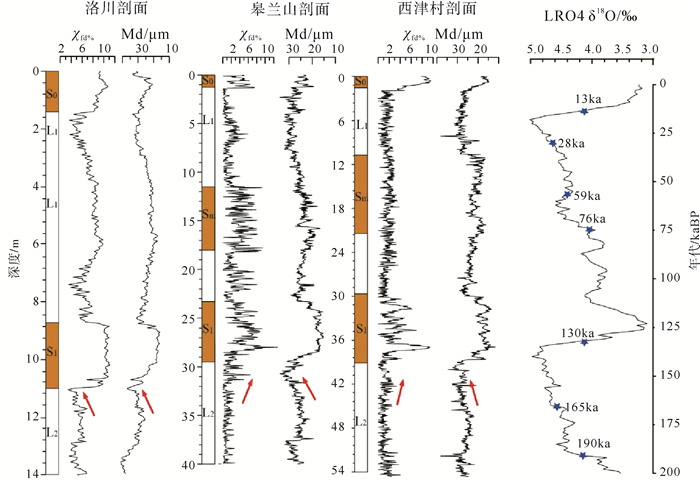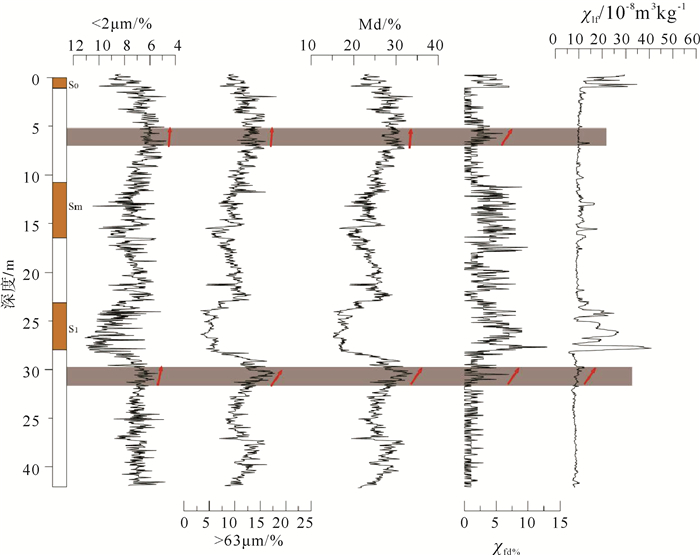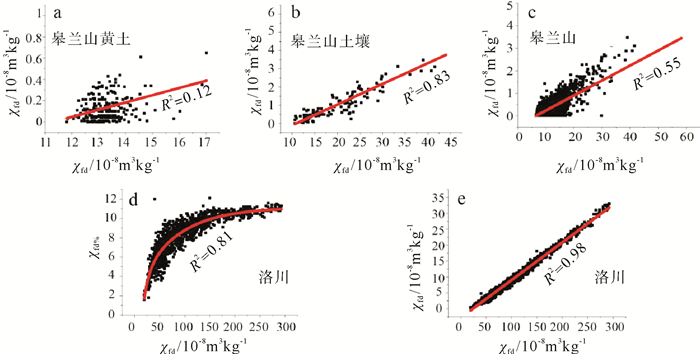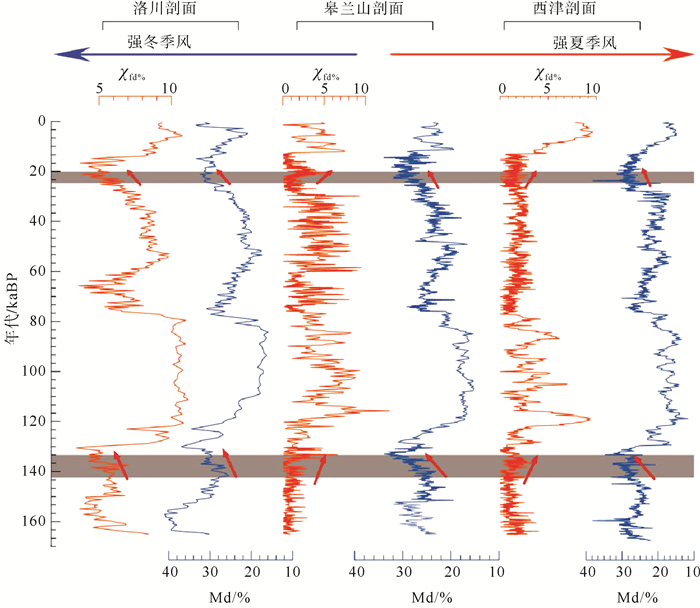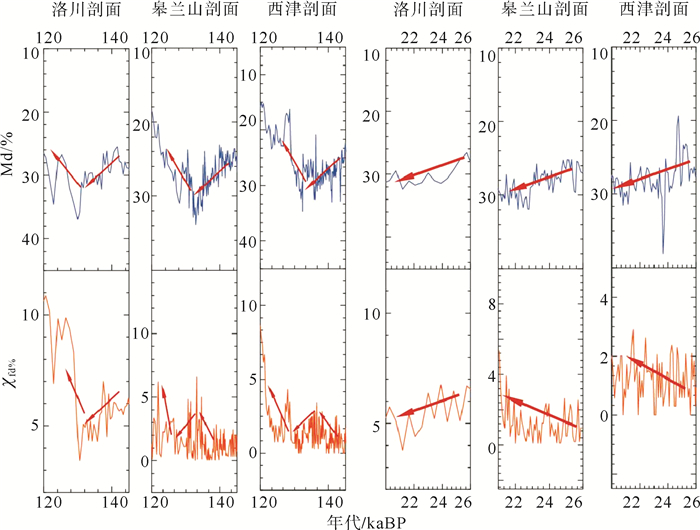Magnetic susceptibility enhancement model and its driving mechanism of Lanzhou loess on the Western Loess Plateau
-
摘要:
我国黄土高原第四纪风成黄土序列为研究不同时间尺度(构造和轨道尺度)的环境演变提供了理想材料,其中轨道尺度上冰期-间冰期气候变化是第四纪以来气候周期性演变的重要特征。粒度和磁化率分别作为冬季风和夏季风指标被广泛应用于亚洲内陆干旱化和古季风演化研究。然而,磁化率作为古气候代用指标在解释区域环境演化时存在差异性,并不能将其总视为暖湿信号。以黄土高原西部地区的兰州皋兰山和西津岩心为研究对象,详细分析了倒数第二次冰期以来的粒度和磁化率特征,并与洛川剖面进行空间对比。研究表明,间冰期的磁化率总体高于冰期,但在冰期向间冰期转换的过渡期,皋兰山和西津岩心磁化率值并没有降低到冰期水平,而与弱发育古土壤磁化率水平类似。我们推测该时段兰州黄土磁化率增加并非由成壤作用增强贡献,而是源区粗颗粒磁性矿物增加所致,其磁化率增强模式可能同阿拉斯加、新疆黄土类似。由此可见,磁化率增强模式不仅在冰期时黄土高原东西部存在显著差异,而且在同一区域的不同沉积时期也存在较大差别。
Abstract:The Quaternary loess-paleosol sequence provides an ideal document for studying both the tectonic and orbital scale environmental evolutions. And the Quaternary climate is characterized by the glacial-interglacial cycle on the orbital scale. Grain size and magnetic susceptibility are the classic proxies for the winter and summer monsoon respectively, which reveals the interior Asian aridification and monsoon evolution history. Actually, as the summer monsoon proxy, the magnetic susceptibility is restricted by regional climate background and can not always be used to represent the warm/humid signal. In this study, we firstly reconstructed the penultimate glacial grain size and magnetic susceptibility variations for the Gaolanshan and Xijin cores located in the western part of Chinese Loess Plateau. And then the potential reasons for the magnetic susceptibility model were discussed based on the spatial comparison between the western and eastern Chinese Loess Plateau. Our results indicate that the interglacial magnetic susceptibility of the Gaolanshan and Xijin loess is higher than the glacial one. However, during the interval of glacial-interglacial transitions (140~130ka and 22ka), the magnetic susceptibility values did not reduce to the glacial level, but similar to the weak paleosol level. We ascribe the enhanced magnetic susceptibility to the increased magnetic particles, which were derived from the source region and carried by the winter monsoon, but did not form by pedogensis. So this enhanced model of magnetic susceptibility during the glacial-interglacial transitions is different from that of the eastern Chinese Loess Plateau, and similar to that of the Alaska loess. Therefore, the magnetic susceptibility enhancement mechanism is different in both the different part of Chinese Loess Plateau, and the different depositional stage of the Lanzhou loess.
-
Key words:
- magnetic susceptibility /
- glacial-interglacial /
- Lanzhou loess /
- Gaolanshan core
-

-
图 4 皋兰山岩心和洛川剖面磁学参数关系(洛川剖面数据来自文献[36])
Figure 4.
-
[1] Cheng H, Edwards R L, Sinhai A, et al. The Asian monsoon over the past 640000 years and ice age terminations[J]. Nature, 2016, 534(7609): 640-646. doi: 10.1038/nature18591
[2] Wang Y J, Cheng H, Edwards R L, et al. A high-resolution absolute-dated late Pleistocene monsoon record from Hulu Cave, China[J]. Science, 2002, 294(5550): 2345-2348. http://d.old.wanfangdata.com.cn/NSTLQK/10.1126-science.1064618/
[3] Ruddiman W F. Orbital insolation, ice volume, and greenhouse gases[J]. Quaternary Science Reviews, 2003, 22(15-17): 1597-1629. doi: 10.1016/S0277-3791(03)00087-8
[4] Heller F, Liu T S. Palaeoclimatic and sedimentary history from magnetic susceptibility of loess in China[J]. Geophysical research letters, 1986, 13(11): 1169-1172. doi: 10.1029/GL013i011p01169
[5] Kukla A G, Heller F, Liu X M, et al. Pleistocene climates in china dated by magnetic susceptibility[J]. Geology, 1988, 16(9): 811-814. doi: 10.1130/0091-7613(1988)016<0811:PCICDB>2.3.CO;2
[6] Banerjee S K, Hunt C P, Liu X M. Separation of local signals from the regional paleomonsoon record of the Chinese Loess Plateau: A rock‐magnetic approach[J]. Geophysical Research Letters, 1993, 20(9): 843-846. doi: 10.1029/93GL00908
[7] Maher B A, Thompson R. Paleorainfall reconstructions from pedogenic magnetic susceptibility variations in the Chinese loess and paleosols[J]. Quaternary Research, 1995, 44(3): 383-391. doi: 10.1006/qres.1995.1083
[8] An Z S, Porter S C. Millennial-scale climatic oscillations during the last interglaciation in central China[J]. Geology, 1997, 25(7): 603-606. doi: 10.1130/0091-7613(1997)025<0603:MSCODT>2.3.CO;2
[9] Liu T S, Ding Z L, Rutter N. Comparison of Milankovitch periods between continental loess and deep sea records over the last 2.5 Ma[J]. Quaternary Science Reviews, 1999, 18(10-11): 1205-1212. doi: 10.1016/S0277-3791(98)00110-3
[10] Ding Z L, Derbyshire E, Yang S L, et al. Stacked 2.6-Ma grain size record from the Chinese loess based on five sections and correlation with the deep-sea δ18O record[J]. Paleoceanography, 2002, 17(3): 5-1-5-21. https://agupubs.onlinelibrary.wiley.com/doi/full/10.1029/2001PA000725
[11] Heller F, Liu T S. Magnetostratigraphical dating of loess deposits in China[J]. Nature, 1982, 300(5891): 431-433. doi: 10.1038/300431a0
[12] Zhou L P, Oldfield F, Wintle A G, et al. Partly pedogenic origin of magnetic variations in Chinese loess[J]. Nature, 1990, 346(6286): 737-739. doi: 10.1038/346737a0
[13] Porter S C, An Z S. Correlation between climate events in the North Atlantic and China during the last glaciation[J]. Nature, 1995, 375(6529): 305-308. doi: 10.1038/375305a0
[14] 鹿化煜, 安芷生.洛川黄土粒度组成的古气候意义[J].科学通报, 1997, 42(1): 67-69. http://www.cqvip.com/Main/Detail.aspx?id=2528794
LU Huayu, AN Zhisheng. Paleoclimatic significance of grain size of loess-palaeosol deposit in Chinese Loess Plateau[J]. Chinese Science Bulletin, 1998, 28(3): 278-283. http://www.cqvip.com/Main/Detail.aspx?id=2528794
[15] Sun Y B, Lu H Y, An Z S. Grain size of loess, palaeosol and Red Clay deposits on the Chinese Loess Plateau: Significance for understanding pedogenic alteration and palaeomonsoon evolution[J]. Palaeogeography, Palaeoclimatology, Palaeoecology, 2006, 241(1): 129-138. doi: 10.1016/j.palaeo.2006.06.018
[16] 刘东生.黄土与环境[M].北京:科学出版社, 1985.
LIU Tunsheng. Loess and Environment[M]. Beijing: Science Press, 1985.
[17] An Z S, Kukla G, Porter S C, et al. Late Quaternary dust flow on the Chinese loess plateau[J]. Catena, 1991, 18(2): 125-132. doi: 10.1016/0341-8162(91)90012-M
[18] Ding Z, Yu Z, Rutter N W, et al. Towards an orbital time scale for Chinese loess deposits[J]. Quaternary Science Reviews, 1994, 13(1): 39-70. doi: 10.1016/0277-3791(94)90124-4
[19] Balsam W L, Ellwood B B, Ji J F, et al. Magnetic susceptibility as a proxy for rainfall: Worldwide data from tropical and temperate climate[J]. Quaternary Science Reviews, 2011, 30(19-20): 2732-2744. doi: 10.1016/j.quascirev.2011.06.002
[20] Maher B A. Palaeoclimatic records of the loess/palaeosol sequences of the Chinese Loess Plateau[J]. Quaternary Science Reviews, 2016, 154: 23-84. doi: 10.1016/j.quascirev.2016.08.004
[21] Heller F, Liu T S. Magnetism of Chinese loess deposits[J]. Geophysical Journal International, 1984, 77(1): 125-141. doi: 10.1111/j.1365-246X.1984.tb01928.x
[22] Evans M E, Heller F. Magnetism of loess/palaeosol sequences: recent developments[J]. Earth-Science Reviews, 2001, 54(1-3): 129-144. doi: 10.1016/S0012-8252(01)00044-7
[23] Sun J M, Liu T S. Multiple origins and interpretations of the magnetic susceptibility signal in Chinese wind-blown sediments[J]. Earth & Planetary Science Letters, 2000, 180(3-4): 287-296. http://www.wanfangdata.com.cn/details/detail.do?_type=perio&id=77e8b9fdc2ef093555869d699e178842
[24] 李志文, 李保生, 孙丽, 等.影响中国黄土磁化率差异的多因素评述[J].中国沙漠, 2008, 28(2): 231-237. http://d.old.wanfangdata.com.cn/Periodical/zgsm200802008
LI Zhiwen, LI Baosheng, SUN Li, et al. Evaluation of Multifactors that affect the susceptibility of China's loess[J]. Journal of Desert Research, 2008, 28(2): 231-237. http://d.old.wanfangdata.com.cn/Periodical/zgsm200802008
[25] Begét J E, Hawkins D B. Influence of orbital parameters on Pleistocene loess deposition in central Alaska[J]. Nature, 1989, 337(6203): 151-153. doi: 10.1038/337151a0
[26] Begét J E, Stone D B, Hawkins D B. Paleoclimatic forcing of magnetic susceptibility variations in Alaskan loess during the late Quaternary[J]. Geology, 1990, 18(1): 40-43. doi: 10.1130/0091-7613(1990)018<0040:PFOMSV>2.3.CO;2
[27] 刘秀铭, 刘东生, 夏敦胜, 等.中国与西伯利亚黄土磁化率古气候记录-氧化和还原条件下的两种成土模式分析[J].中国科学:地球科学, 2007, 37(10): 1382-1391. http://d.old.wanfangdata.com.cn/Periodical/zgkx-cd200710010
LIU Xiuming, LIU Tunsheng, XIA Dunsheng, et al. Two pedogenic models for paleoclimatic records of magnetic susceptibility from Chinese and Siberian loess[J]. Science in China Series D: Earth Sciences, 2008, 51(2): 284-293. http://d.old.wanfangdata.com.cn/Periodical/zgkx-cd200710010
[28] 吕厚远, 韩家懋, 吴乃琴, 等.中国现代土壤磁化率分析及其古气候意义[J].中国科学:化学, 1994, 24(12): 1290-1297. http://www.wanfangdata.com.cn/details/detail.do?_type=perio&id=QK199400230232
LV Houyuan, HAN Jiamao, WU Naiqin, et al. The magnetic susceptibility of modern soils in China and its use for paleoclimate reconstruction[J]. Science in China (Series B), 1996, 40(3): 262-275. http://www.wanfangdata.com.cn/details/detail.do?_type=perio&id=QK199400230232
[29] Song Y G, Shi Z T, Fang X M, et al. Loess magnetic properties in the Ili Basin and their correlation with the Chinese Loess Plateau[J]. Science China Earth Sciences, 2010, 53(3): 419-431. doi: 10.1007/s11430-010-0011-5
[30] Chen Q, Liu X M, Heller F, et al. Susceptibility variations of multiple origins of loess from the Ily Basin (NW China)[J]. Chinese Science Bulletin, 2012, 57(15): 1844-1855. doi: 10.1007/s11434-012-5131-1
[31] 李传想, 宋友桂.新疆伊犁黄土磁化率增强机制差异性分析[J].地球学报, 2011, 32(1): 80-86. doi: 10.3975/cagsb.2011.01.10
LI Chuanxiang, SONG Yougui. Differences in magnetic susceptibility enhancement in Ili loess[J]. Acta Geoscientica Sinica, 2011, 32(1): 80-86. doi: 10.3975/cagsb.2011.01.10
[32] 史正涛, 董铭, 方小敏.伊犁盆地晚更新世黄土—古土壤磁化率特征[J].兰州大学学报:自然科学版, 2007, 43(2): 7-10. http://d.old.wanfangdata.com.cn/Periodical/lzdxxb200702002
SHI Zhengtao, DONG Ming, FANG Xiaomin. The characteristics of later pleistocene loess-paleosol magnetic susceptibility in Yili Basin[J]. Journal of Lanzhou University: Natural Sciences, 2007, 43(2): 7-10. http://d.old.wanfangdata.com.cn/Periodical/lzdxxb200702002
[33] 叶玮.新疆西风区黄土与古土壤磁化率变化特点[J].中国沙漠, 2001, 21(4): 380-386. doi: 10.3321/j.issn:1000-694X.2001.04.011
YE Wei. Study on magnetic susceptibility of loess and paleosol sequences in westerly region of Xinjiang[J]. Journal of Desert Research, 2001, 21(4): 380-386. doi: 10.3321/j.issn:1000-694X.2001.04.011
[34] 昝金波, 杨胜利, 方小敏, 等.西昆仑山黄土的岩石磁学特征及其磁化率增强机制[J].第四纪研究, 2010, 30(1): 46-53. doi: 10.3969/j.issn.1001-7410.2010.01.04
ZAN Jinbo, YANG Shili, FANG Xiaomin, et al. Rock-magnetic characteristics and the enhancing mechanism of magnetic susceptibility for west Kunlun mountains loess[J]. Quaternary Sciences, 2010, 30(1): 46-53. doi: 10.3969/j.issn.1001-7410.2010.01.04
[35] Zhang J, Li J J, Guo B H, et al. Magnetostratigraphic age and monsoonal evolution recorded by the thickest Quaternary loess deposit of the Lanzhou region, western Chinese Loess Plateau[J]. Quaternary Science Reviews, 2016, 139: 17-29. doi: 10.1016/j.quascirev.2016.02.025
[36] Hao Q Z, Wang L, Oldfield F, et al. Delayed build-up of Arctic ice sheets during 400, 000-year minima in insolation variability[J]. Nature, 2012, 490(7420): 393-396. doi: 10.1038/nature11493
[37] Li J J, Feng Z D, Tang L Y. Late Quaternary monsoon patterns on the Loess Plateau of China[J]. Earth Surface Processes and Landforms, 1988, 13(2): 125-135. doi: 10.1002/esp.3290130204
[38] 罗思维.冬季我国高原东侧切变线形成的分析[J].气象学报, 1963, 33(3): 14. http://www.cnki.com.cn/Article/CJFDTotal-QXXB196303003.htm
LUO Siwei. Analysis of shear line formation on the east side of Plateau in winter[J]. Acta Meteorologica Sinica, 1963, 33(3): 14. http://www.cnki.com.cn/Article/CJFDTotal-QXXB196303003.htm
[39] 戴雪荣, 李吉均, 俞立中, 等.兰州风尘沉积的粒度分布模式及其古气候意义[J].沉积学报, 2000, 18(1): 36-42. doi: 10.3969/j.issn.1000-0550.2000.01.007
DAI Xuerong, LI Jijun, YU Lizhong, et al. Model of Grain-size distribution of the Eolian deposits in Lanzhou area and its paleoclimatic significances[J]. Acta Sedimentologica Sinca, 2000, 18(1): 36-42. doi: 10.3969/j.issn.1000-0550.2000.01.007
[40] Liu J, Li J J, Song C H, et al. Palynological evidence for late Miocene stepwise aridification on the northeastern Tibetan Plateau[J]. Climate of the Past, 2016, 12(7): 1473-1484. doi: 10.5194/cp-12-1473-2016
[41] Yuan D Y, Wang L M, He W G, et al. New progress of seismic active fault prospecting in Lanzhou city[J]. Seismology and Geology, 2008, 30(1): 236-249. http://www.wanfangdata.com.cn/details/detail.do?_type=perio&id=dzdz200801017
[42] Liu Q S, Deng C L. Magnetic susceptibility and its environmental significances[J]. Chinese Journal of Geophysics, 2009, 52(4): 1041-1048. http://d.old.wanfangdata.com.cn/Periodical/dqwlxb200904021
[43] 邓成龙, 刘青松, 潘永信, 等.中国黄土环境磁学[J].第四纪研究, 2007, 27(2): 193-209. doi: 10.3321/j.issn:1001-7410.2007.02.005
DENG Chenglong, LIU Qinsong, PAN Yongxin, et al. Environmental magnetism of Chinese Loess-Paleosol sequences[J]. Quaternary Sciences, 2007, 27(2): 193-209. doi: 10.3321/j.issn:1001-7410.2007.02.005
[44] Lisiecki L E, Raymo M E. A Pliocene-Pleistocene stack of 57 globally distributed benthic δ18O records[J]. Paleoceanography and paleoclimatology, 2005, 20(1): PA1003. https://agupubs.onlinelibrary.wiley.com/doi/10.1029/2005PA001164
[45] 刘现彬, 夏敦胜, 贾佳, 等.兰州九州台黄土磁性特征及其古气候意义研究[J].第四纪研究, 2012, 32(4): 761-770. doi: 10.3969/j.issn.1001-7410.2012.04.21
LIU Xianbing, XIA Dunsheng, JIA Jia, et al. Magnetic properties of Jiuzhoutai Loess in Lanzhou and its significance of palaeoclimate[J]. Quaternary Sciences, 2012, 32(4): 761-770. doi: 10.3969/j.issn.1001-7410.2012.04.21
[46] Worm H U. On the superparamagnetic—stable single domain transition for magnetite, and frequency dependence of susceptibility[J]. Geophysical Journal International, 1998, 133(1): 201-206. doi: 10.1046/j.1365-246X.1998.1331468.x
[47] 吕镔, 刘秀铭, 赵国永, 等.新疆博乐黄土岩石磁学特征及环境意义[J].兰州大学学报:自科版, 2012, 48(5): 1-8. http://d.old.wanfangdata.com.cn/Periodical/lzdxxb201205001
LV Bin, LIU Xiumin, ZHAO Guoyong, et al. Rock magnetic properties of Bole loess in Xinjiang and Its environmental significance[J]. Journal of Lanzhou University: Natural Sciences, 2012, 48(5): 1-8. http://d.old.wanfangdata.com.cn/Periodical/lzdxxb201205001
[48] 强小科, 孙玉芳, 陈艇, 等.末次冰期以来黄土高原粉尘沉积的岩石磁学空间特征[J].地球环境学报, 2012, 3(2): 810-818. http://www.cnki.com.cn/Article/CJFDTotal-DQHJ201202007.htm
QIANG Xiaoke, SUN Yufang, CHEN Ting, et al. Mineral magnetism and the spatial comparison of the loess sediments in loess Plateau since the last glacial period[J]. Journal of Earth Environment, 2012, 3(2): 810-818. http://www.cnki.com.cn/Article/CJFDTotal-DQHJ201202007.htm
[49] 陈发虎, 潘保田, 陈国荣, 等.兰州地区晚更新世古风成砂的发现及环境变化[J].中国沙漠, 1990, 10(2): 1-84. http://www.cnki.com.cn/Article/CJFDTotal-ZGSS199002000.htm
CHEN Fahu, PAN Baotian, CHEN Guorong, et al. The discovery of Palaeo-Eolian sand and environmental changes of the late Pleistocene in Lanzhou area[J]. Journal of Desert Research, 1990, 10(2): 1-84. http://www.cnki.com.cn/Article/CJFDTotal-ZGSS199002000.htm
[50] 冯晗, 鹿化煜, 弋双文, 等.末次盛冰期和全新世大暖期中国季风区西北缘沙漠空间格局重建初探[J].第四纪研究, 2013, 33(2):252-259. doi: 10.3969/j.issn.1001-7410.2013.02.06
FENG Han, LU Huayu, YI Shangwen, et al. The border changes of the deserts/sand field in the East Asina monsoon marginal region during the last glacial maximum and Holocene optimum[J]. Quaternary Research, 2013, 33(2):252-259. doi: 10.3969/j.issn.1001-7410.2013.02.06
[51] 夏敦胜, 魏海涛, 马剑英, 等.中亚地区现代表土磁学特征及其古环境意义[J].第四纪研究, 2006, 26(6): 937-946. doi: 10.3321/j.issn:1001-7410.2006.06.008
XIA Dunsheng, WEI Haitao, MA Jianying, et al. Magnetic characteristics of surface soil in arid region of central Asia and their paleoenvironmental significance[J]. Quaternary Sciences, 2006, 26(6): 937-946. doi: 10.3321/j.issn:1001-7410.2006.06.008
[52] 李平原, 刘秀铭, 郭雪莲, 等.西北戈壁沙漠-黄土高原区表土磁化率特征及其意义[J].第四纪研究, 2013, 33(2): 360-367. doi: 10.3969/j.issn.1001-7410.2013.02.18
LI Pingyuan, LIU Xiuming, Guo Xuelian, et al. The magnetic susceptibility properties of top soil's in Gobi-Loess plateau, northwest China[J]. Quaternary Sciences, 2013, 33(2): 360-367. doi: 10.3969/j.issn.1001-7410.2013.02.18
-




 下载:
下载:
